Pope St John Paul II – the People’s Pope
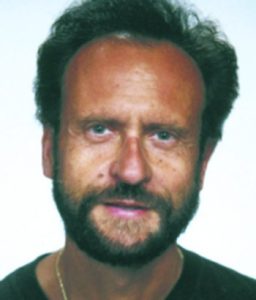
By Victor M
Parachin
The future starts today, not tomorrow
- John Paul II
In January 1945, as World War II was ending, the German army began retreating from Poland, providing new freedoms for the people. One who benefitted from the retreat was a young teenage girl named Edith Zierer, who managed to escape from a Nazi labour camp. Though she was in a desperately weakened condition, she managed to walk to a train station. There, the teen had spent two days huddled in a corner of the station without food and water when a young man approached her.
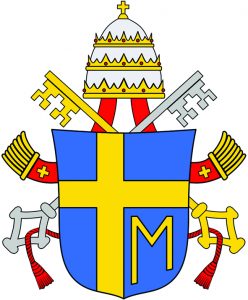
He wore the long robe of a Catholic seminarian, though she mistook him for a priest. The man asked about her circumstances and the teen explained, adding that she was hoping to be reunited with her family in Krakow. She did not know they had already perished in the Holocaust.
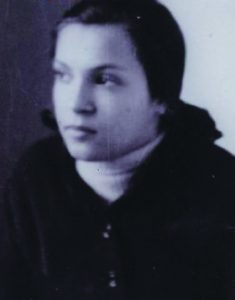
Edith Zierer in 1946
Seeing that she was hungry and thirsty, the seminarian disappeared, returning with a cup of tea, bread and cheese. Offering to help her get to Krakow, he asked her to try and stand. She was unable to, so the man carried her to the train and into a car. “He sat with me and put his cloak on me because it was freezing”, Zierer recalls. They made it to Krakow, and after parting company, Zierer quickly wrote his name in a small journal she kept – Karol Wojtyla.
Thirty-three years later, that seminarian who treated her with care and compassion, would become Pope John Paul II.
The man who became the most energetic, charismatic and influential pope in modern times was born Karol Wojtyla on 18 May 1920 in Wadowice, Poland. He was the second child of Karol Wojtyla, Sr., an army sergeant, and Emilia Wojtyla. The first two decades of Wojtyla’s life were impacted by heavy suffering. He was in third grade when his mother died. Four years later, his only sibling, an older brother, also died. In 1941, Karol Wojtyla, Sr., died leaving the younger Karol an orphan. Of that time period, John Paul would later observe, “At twenty, I had already lost all the people I loved ... I was not old enough to make my First Communion when I lost my mother. My brother Edmund died from scarlet fever in a virulent epidemic at the hospital where he was starting as a doctor. After my father’s death, which occurred in February 1941, I gradually become aware of my true path”.
That path was a vocation to the priesthood. Because of World War II and the invasion of Poland by the Nazis, it was not an easy path. Publicly he met the German demand for labourers by working in a stone quarry and a chemical plant. Privately, he enrolled in a clandestine seminary in Kraków run secretly by Cardinal Adam Stefan Sapieha, the Archbishop of Kraków.
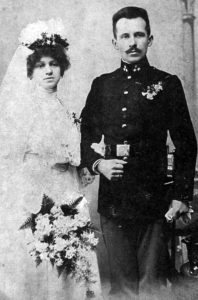
John Paul II’s parents’ wedding portrait
When the war ended in 1945, Polish universities re-opened, allowing Wojtyla to resume studies in the faculty of theology at the Jagiellonian University. He was ordained to the priesthood by Archbishop Sapieha in Kraków on 1 November 1946. Because of his strong academic skills, Cardinal Sapieha sent him to Rome, where he earned a doctorate in theology in 1948. His dissertation focussed on faith in the writing of St John of the Cross.
Returning to Poland, he served as priest at several parishes in Kraków and was chaplain to university students. Again, his academic talents were acknowledged when he was given leave, in 1951, to take up further studies in philosophy. Two years later he earned a second doctorate. He became professor of moral theology and social ethics at the major seminary of Kraków and simultaneously was on the Faculty of Theology of Lublin.
Along with academic skills, Wojtyla possessed powerful pastoral talents. These were noted by Catholic authorities. On 4 July 1958, Pope Pius XII appointed him Auxiliary Bishop of Krakow. Six years later, Pope Paul VI appointed him Archbishop of Kraków and later, (1967) appointed him as a Cardinal.
As a leader of Polish Catholics, Wojtyla was cautious about direct confrontation with Communist authorities. It was a style which served him and his church effectively. In his book, A Life With Karol: My Forty-Year Friendship With The Man Who Became Pope, Cardinal Stanislaw Dziwisz writes that Karol Wojtyla “was always a pastor, never a political agitator. He restricted himself to proclaiming the truth. He followed the Gospel principle that ‘the truth will make you free’, and so by the very fact of proclaiming the truth, he also proclaimed man’s freedom. It was others who went on to draw the practical conclusions from his principles”.
It is highly likely that Wojtyla’s leadership skills in dealing with Polish Communist authorities made him a compelling choice to be elected pope on 16 October 1978. Aware that he might be viewed as an outsider by Italian Catholics, Wojtyla – now Pope John Paul II – greeted the throngs in St. Peter’s square with these words of humility and reassurance:
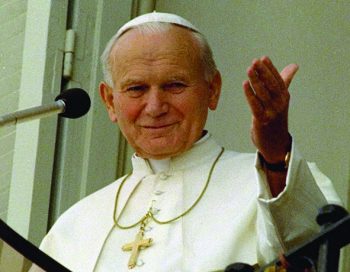
Pope John Paul II in 1989
“Dearest brothers and sisters, we are all still grieved after the death of our most beloved Pope John Paul I. And now the most eminent Cardinals have called a new Bishop of Rome. They have called him from a distant country, distant but always so close through communion in the Christian faith and tradition. I was afraid to accept this nomination, but I did it in the spirit of obedience to our Lord Jesus Christ and of total confidence in his Mother, the most holy Madonna ... I present myself to you to confess our common faith, our hope, our confidence in the Mother of Christ and of the Church, also to start anew on this road of history and of the Church, with the help of God and with the help of all people”.
Thus, began a papacy which would be remarkable and astonishing for its pace and accomplishments. Here are some examples:
- As Bishop of Rome he visited 301 of the 334 parishes of Rome.
- He was the most travelled pope in history, having completed 95 pastoral visits outside of Italy and 141 within Italy since 1978. He spent more than one-tenth of his pontificate outside the Vatican.
- During a visit to Spain in 1982 he preached to more than 14.5 million people in 10 days.
- His principal documents include 13 encyclicals, 13 apostolic exhortations, 11 apostolic constitutions and 41 apostolic letters. His letters, sermons and speeches fill nearly 150 volumes.
- John Paul II presided at 131 beatification ceremonies (1,282 blesseds proclaimed) and 43 canonisation ceremonies (456 saints proclaimed) during his pontificate. Brushing off criticism that the Vatican was becoming a ‘saint factory’, he continued to canonise exemplary women and men saying “there can never be enough saints”.
To maintain that pace, Pope John Paul was careful to build times for spiritual, physical and emotional renewal into his schedule. He did this by taking holidays, usually in the Italian Alps. While those times were largely designed to be a private time away from the public, he still reached out to people. Understanding that local people were aware of his presence in their area and not wanting to disappoint them nor deprive them of a once-in-a-lifetime opportunity to be in the presence of a pope, he often recited the Sunday Angelus, a noon service, in the nearest church. This usually resulted in an enormous number of people showing up.
For example, one year when he took his holiday at Combes in the Italian Alps, 5,000 or so people arrived as early as 7:30 am in order to attend the Angelus. By noon, all meadows were transformed into parking lots filled with vehicles. At the service, local children greeted the pope with songs, followed by a brief speech from the Pope thanking officials for their help making his holiday pleasant, adding that “Combes is a quiet spot where the body’s strength is restored and the spirit can focus on reflection and contemplation”. During that service he also spoke compassionately about people whose lives are difficult: “I am thinking especially about those who cannot afford a holiday and had to stay home”, he said. “I send my blessings to the sick, the elderly, prisoners and the lonely”.
As pope, he held strongly to Church tradition calling for an exclusively male priesthood, Pope John Paul II nevertheless spoke highly, respectfully and appreciatively about women. During International Year of the Woman, (1995) he wrote an apostolic Letter To Women, praising their multitudinous contributions and expressing sorrow for injustices committed against them by the Church. “Unfortunately, we are heirs to a history which has conditioned us to a remarkable event. In every time and place this conditioning has been an obstacle to the progress of women ... if objective blame, especially in particular historical contexts, has belonged to not just a few members of the Church, for this I am truly sorry. Women have contributed to ... history as much as men, and more often than not they did so in much more difficult conditions … To this great, immense feminine tradition, humanity owes a debt which can never be repaid”.
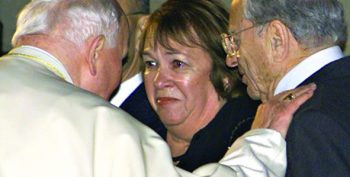
John Paul II meeting Edith Zierer in 2000 at the Yad Vashem Holocaust Memorial in Jerusalem
That same year the pope criticised the fact that too much attention had been placed on men’s achievements while minimising those of women. “I would like to speak in the name of the Church and pay homage to women for the multiple, immense but silent contributions by women in every phase and aspect of human existence”, he wrote.
Over the course of his long papacy, John Paul maintained contact with old friends. One of those was Edith Zierer, the young Jewish teenager he assisted in 1945. Upon learning that Karol Wojtyla had been elected pope, she began to write to him at the Vatican. Eventually, her letters reached him and in 1997 she received an invitation to meet with him. John Paul told her he remembered their encounter vividly.
Despite failing health, John Paul II continued to work and fulfill his duties. He died at the age of 84 on 2 April 2005. As word spread, people from all over the world converged on Vatican City. An estimated 3 million people came to pay their respects, with many waiting in lines for more than 24 hours to enter St. Peter’s Basilica.
His successor, Pope Benedict XVI, waived the normal five-year waiting period before beginning the process of beatification and canonisation. Pope Francis canonised him, along with Pope John XXIII, on 27 April 2014.
Words of Wisdom from Pope St John Paul IIThe future is in your hearts and in your hands. God is entrusting to you the task, at once difficult and uplifting, of working with him in the building of the civilisation of love. The truth is not always the same as the majority decision. Freedom consists not in doing what we like, but in having the right to do what we ought. The world you are inheriting is a world which desperately needs a new sense of brotherhood and human solidarity. It is a world which needs to be touched and healed by the beauty and richness of God’s love. Science can purify religion from error and superstition. Religion can purify science from idolatry and false absolutes. Modern Society will find no solution to the ecological problem unless it takes a serious look at its lifestyles. Radical changes in world politics leave America with a heightened responsibility to be, for the world, an example of a genuinely free, democratic, just and humane society. Social justice cannot be attained by violence. Violence kills what it intends to create. Peace is not just the absence of war. Like a cathedral, peace must be constructed patiently and with unshakable faith. |
 Entries(RSS)
Entries(RSS)